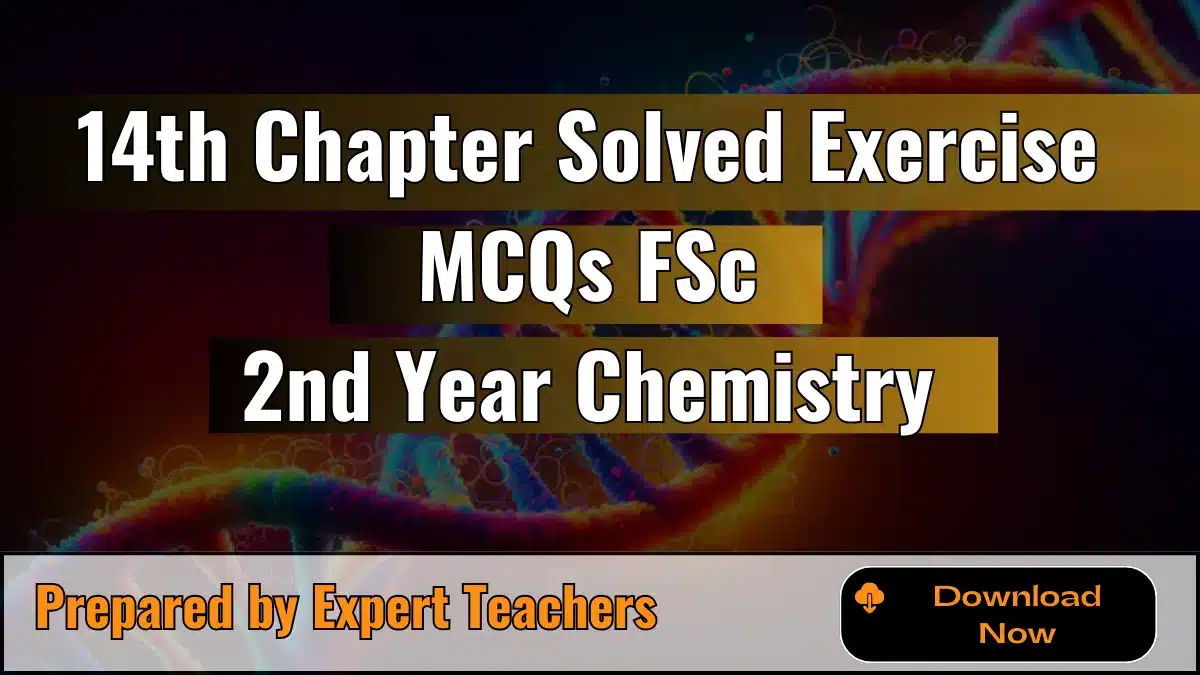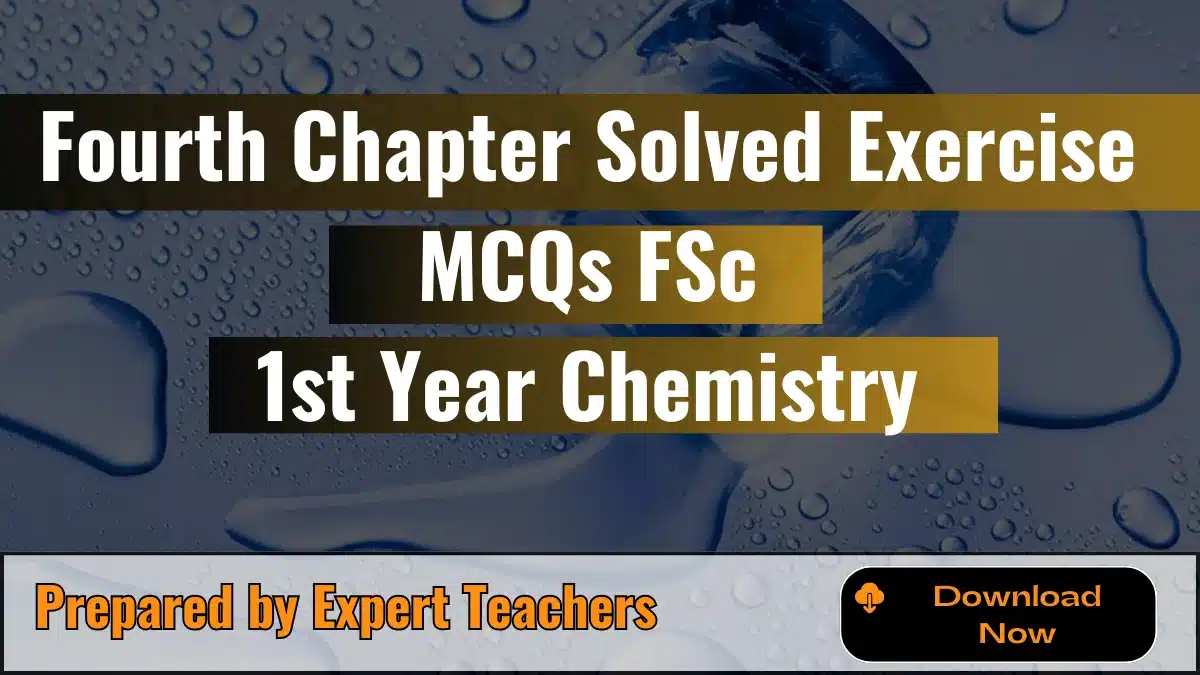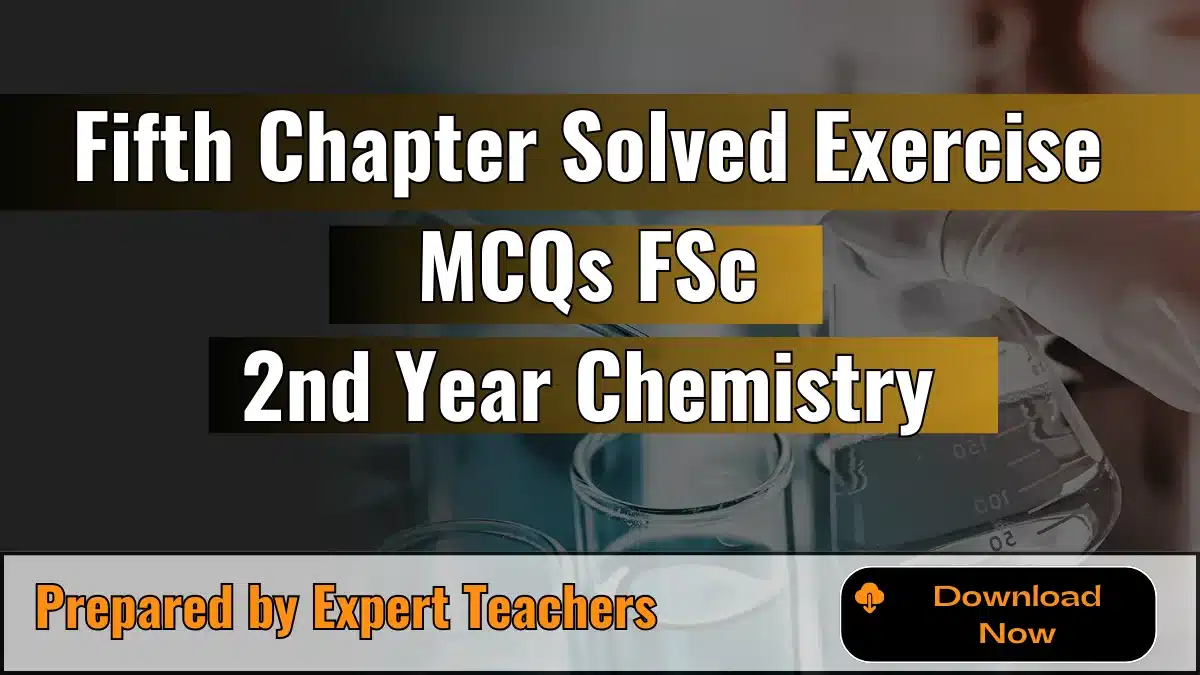16th Chapter Solved Exercise MCQs of FSC Second Year Chemistry
The 16th Chapter Solved Exercise MCQs of FSC 2nd-year Chemistry provides a complete set of solved multiple-choice questions (MCQs). Each MCQ comes with a brief explanation to help you understand the correct answer. These solutions are designed to support students in preparing for their exams, making complex concepts easier to grasp and ensuring a solid foundation for success.
16th chapter solved MCQs with explanation
1. The pH range of the acid rain is:
(a) 7-6.5
(b) 6.5-6
(c) 6-5.6
(d) less than 5
Explanation: Option (d) is correct. Because acid rain forms when sulfur dioxide (SO₂) and nitrogen oxides (NOₓ) in the atmosphere react with water vapor to form sulfuric and nitric acids, which make the rain more acidic. Typically, the pH of acid rain is in the range of about 4 to 5.
2. Peroxyacetylnitrate (PAN) is an irritant to human beings and it affects:
(a) eyes
(b) ears
(c) stomach
(d) nose
Explanation: Option (d) is correct. Because Peroxyacetylnitrate (PAN) is a type of photochemical oxidant. It is known to be an irritant to the respiratory system. When inhaled, PAN can cause irritation to the mucous membranes of the nose and throat. This is why it’s primarily associated with affecting the nose.
3. To avoid the formation of toxic compounds with chlorine, which substance is used for disinfecting water?
(a) KMnO₄
(b) O₃
(c) Alums
(d) Chloramines
Explanation: Option (d) is correct. Because chloramines are less likely to form toxic by-products compared to chlorine. When chlorine is used alone, it can react with organic matter in the water to produce potentially harmful compounds like trihalomethanes (THMs). Chloramines, which are compounds of chlorine and ammonia, help reduce the formation of these toxic by-products while still effectively disinfecting the water.
4. A single chloride free radical can destroy how many ozone molecules:
(a) 100
(b) 100,000
(c) 10,000
(d) 10
Explanation: Option (b) is correct. Because a single chloride free radical (Cl•) can destroy approximately 100,000 ozone (O₃) molecules. This is due to the catalytic nature of the chlorine radical in the ozone depletion process. Chlorine radicals are very reactive and can initiate a chain reaction where one Cl• can break down many ozone molecules before being deactivated.
5. Fungicides are the pesticides which:
(a) control the growth of fungus
(b) kill insects
(c) kill plants
(d) kill herbs
Explanation: Option (a) is correct. Because fungicides are chemicals specifically designed to prevent or control fungal infections in plants, crops, or other surfaces. They work by inhibiting the growth of fungi, not by killing insects, plants, or herbs.
6. Ecosystem is a smaller unit of:
(a) lithosphere
(b) hydrosphere
(c) atmosphere
(d) biosphere
Explanation: Option (d) is correct. Because an ecosystem is a smaller unit within the biosphere, which includes all living organisms and their interactions. The biosphere encompasses various ecosystems like forests and oceans. The lithosphere, hydrosphere, and atmosphere are physical components, not ecosystems themselves.
7. The main pollutant of leather tanneries in the waste water is due to the salt of:
(a) lead
(b) chromium(VI)
(c) copper
(d) chromium(III)
Explanation: Option (b) is correct. Because leather tanneries commonly use chromium salts in the tanning process, and these salts can be either chromium(III) or chromium(VI). However, chromium(VI) is the main pollutant in wastewater because it is more toxic and environmentally harmful compared to chromium(III). Chromium(VI) can contaminate water sources and poses significant health risks, making it a major concern in tannery waste management.
8. In the purification of potable water the coagulant used is:
(a) nickel sulfate
(b) copper sulfate
(c) barium sulfate
(d) alum
Explanation: Option (d) is correct. Because in the purification of potable water, alum (potassium alum or aluminum sulfate) helps in the process of coagulation and flocculation, where it causes small particles and impurities in the water to clump together into larger particles called flocs. These flocs can then be easily removed by sedimentation or filtration. The other substances listed (nickel sulfate, copper sulfate, and barium sulfate) are not typically used for this purpose.
9. The temperature in the non-rotating chamber in the incineration of industrial and hazardous waste process has a range:
(a) 900 to 1000°C
(b) 250 to 500°C
(c) 950 to 1300°C
(d) 500 to 900°C
Explanation: Option (c) is correct. Because in the incineration of industrial and hazardous waste, the non-rotating chamber (or primary chamber) typically operates at high temperatures to ensure complete combustion of the waste materials. The temperature range of 950 to 1300°C is necessary to effectively break down hazardous substances and achieve complete destruction. Lower temperatures might not be sufficient to incinerate all types of industrial and hazardous waste safely.
10. Newspaper can be recycled again and again by how many times?
(a) 2
(b) 3
(c) 4
(d) 5
Explanation: Option (c) is correct. Because newspaper can generally be recycled about 4 to 5 times. Each time it is recycled, the paper fibers become shorter and weaker, which limits the number of times it can be processed. After several cycles, the fibers are no longer strong enough to produce new paper products.







Leave a Reply